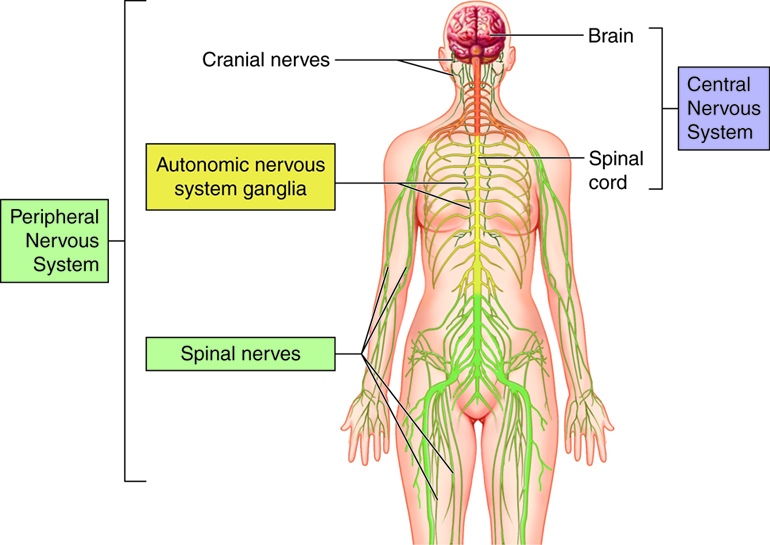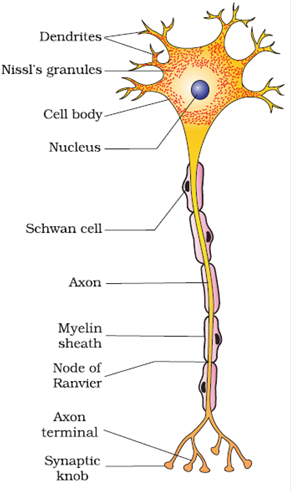CBSE Class 11 Biology Chapter 21 Revision Notes Part 1
Chapter 21: Neural COntrol and Coordination Revision Notes Part 1
The neural and endocrine systems work together to coordinate and integrate all of the body’s operations to run smoothly. While the brain system offers a well-organized network of point-to-point connections for quick coordination, the endocrine system uses hormones to enable chemical integration.
Neural System
-
The neural system comprises neurons, highly specialized cells that can receive and send many types of messages.
-
A network of neurons is present in invertebrates like Hydra.
-
In insects, the nervous system is made up of several ganglia and neural tissues. In vertebrates, it is well developed.
Human Nervous System
The human nervous system is divided into 4 parts: the central nervous system, the peripheral nervous system, the somatic neural system, and the autonomic nervous system. Let’s briefly go over each below.

The Central Nervous System (CNS)
-
The spinal cord and brain are two parts of the central nervous system.
-
The central nervous system of vertebrates is hollow and dorsal, whereas the central nervous system of invertebrates is ventral and solid.
Peripheral Nervous System(PNS)
-
The peripheral nervous system is made up of nerves that connect the central nervous system to various bodily sections.
-
It is made up of both cranial and spinal nerves.
-
It is in charge of all the body’s voluntary functions.
Somatic Neural System
The somatic neural system sends impulses from the CNS to skeletal muscles.
Autonomic Nervous System(ANS)
-
The system sends signals from the CNS to the body’s involuntary organs and smooth muscles.
-
It comprises nerve fibers and regulates the body’s involuntary activities.
-
The sympathetic and parasympathetic nerves make up this system.
Neurons

The cell body, dendrites, and axon are the three primary elements of a neuron. Cell organelles and a few granules known as Nissl’s granules are found in the cytoplasm of the cell body.
-
Dendrites are short threads that branch and arise from the cell body repeatedly. They send electrical impulses to the cell body.
-
Axons are lengthy filaments with a branching distal end. Each branch concluded in a synaptic knob, a bulb-like structure of synaptic vesicles carrying neurotransmitters. Axons carry nerve impulses from the cell body to the synapse. Neurons are multipolar, bipolar, or have two or more dendrites based on the number of axons. Myelinated and non-myelinated axons exist.
-
The Schwann cells generate the myelin sheath surrounding the axon, enclosing the myelinated nerve fibers.
-
Nodes of Ranvier are gaps between two neighboring myelin sheaths.
Nerve Impulse Conduction
Let’s go through why and how nerve impulses actually work step-by-step.
-
The axon membrane is more permeable to potassium ions but impermeable to sodium ions, and negatively charged proteins are found in axoplasm when neurons are in their resting stage (not transmitting any impulse).
-
Plasma in axons has a low sodium ion concentration and a higher potassium ion and protein content.
-
The liquid outside the axon has a high sodium ion concentration and a low potassium ion concentration, resulting in a concentration gradient.
-
The sodium-potassium pump actively transports ions across the membrane, with three sodium ions moving outwards and two potassium ions moving into the cell. As a result, the membrane’s outer surface becomes positively charged while the inner surface becomes negatively charged, resulting in the cell becoming polarised and developing a resting potential.
-
When a stimulus is provided to a polarised membrane at a specific location, the membrane becomes permeable to sodium ions, allowing sodium ions to enter the cell. The membrane’s outside becomes negatively charged, while the inner side becomes positively charged. The membrane has now been depolarized.
-
The action potential is the electrical potential difference created across the plasma membrane at this location.
-
This region serves as a trigger for the depolarization of the membrane’s neighboring area. The migration of sodium ions outside the cell causes the preceding membrane to repolarize. This is the way impulses are carried out.
Transmission of the Nerve Impulse

-
Synapses, produced by the membranes of a pre-synaptic and post-synaptic neuron, convey nerve impulses from one neuron to another.
-
Electrical and chemical synapses are the two types of synapses.
-
The migration of synaptic vesicles towards the membrane is triggered when an impulse reaches the axon terminal.
-
The plasma membrane and vesicles fuse and release neurotransmitters in the synaptic cleft, which bind to particular receptors on the postsynaptic membranes.
Sources
Neural Control and Coordination. https://ncert.nic.in/textbook.php?kebo1=21-22. Accessed 17 Dec, 2021..
]]>